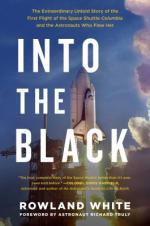July 8, 2019 | sobczakd
On this day, July 8, 2011, Atlantis made its final liftoff from the Kennedy Space Center in Cape Canaveral, Florida. After 31 years of manned space flights into the Earth's orbit and back, the Space Shuttle program was officially retired from service. The shuttle program launched 135 missions, traveled 542,398,878 miles, and flew 21,152 orbits around the Earth, carried 355 people and 3.5 million pounds of payload. The purpose of the program was to transport crew and cargo from Earth to orbit, but its mission expanded to the International Space Station. There were 133 successful flights, but 2 very tragic failures. Both the Challenger and Columbia missions lost 7 crew members each. Want to learn more? Here's some resources to get your started!
On February 1, 2003, Columbia disintegrated on reentry before the nation's eyes, and all seven astronauts aboard were lost. Author Mike Leinbach, Launch Director of the space shuttle program at NASA's John F. Kennedy Space Center was a key leader in the search and recovery effort as NASA, FEMA, the FBI, the US Forest Service, and dozens more federal, state, and local agencies combed an area of rural east Texas the size of Rhode Island for every piece of the shuttle and her crew they could find. Assisted by hundreds of volunteers, it would become the largest ground search operation in US history. For the first time, here is the definitive inside story of the Columbia disaster and recovery and the inspiring message it ultimately holds. In the aftermath of tragedy, people and communities came together to help bring home the remains of the crew and nearly 40 percent of shuttle, an effort that was instrumental in piecing together what happened so the shuttle program could return to flight and complete the International Space Station. Bringing Columbia Home shares the deeply personal stories that emerged as NASA employees looked for lost colleagues and searchers overcame immense physical, logistical, and emotional challenges and worked together to accomplish the impossible. Featuring a foreword and epilogue by astronauts Robert Crippen and Eileen Collins, and dedicated to the astronauts and recovery search persons who lost their lives, this is an incredible, compelling narrative about the best of humanity in the darkest of times and about how a failure at the pinnacle of human achievement became a story of cooperation and hope.
The real-life techno-thriller from a bestselling author and aviation expert that recaptures the historic moments leading up to the launch of the space shuttle Columbia and the exciting story of her daring maiden flight. Using interviews, NASA oral histories, and recently declassified material, Into the Black pieces together the dramatic untold story of the Columbia mission and the brave people who dedicated themselves to help the United States succeed in the age of space exploration. On April 12, 1981, NASA's Space Shuttle Columbia blasted off from Cape Canaveral. It was the most advanced, state-of-the-art flying machine ever built, challenging the minds and imagination of America's top engineers and pilots. Columbia was the world's first real spaceship: a winged rocket plane, the size of an airliner, and capable of flying to space and back before preparing to fly again. On board were moonwalker John Young and test pilot Bob Crippen. Less than an hour after Young and Crippen's spectacular departure from the Cape, all was not well. Tiles designed to protect the ship from the blowtorch burn of re-entry were missing from the heat shield. If the damage to Columbia was too great, the astronauts wouldn't be able to return safely to earth. NASA turned to the National Reconnaissance Office, a spy agency hidden deep inside the Pentagon whose very existence was classified. To help the ship, the NRO would attempt something never done before. Success would require skill, perfect timing, and luck. Set against the backdrop of the Cold War, Into the Black is a thrilling race against time and the incredible true story of the first space shuttle mission that celebrates our passion for spaceflight.
Space Shuttle Columbia: Mission of Hope is a unique story that interweaves the heights of scientific achievement, the depths of a nation's cruelty, the private grief of a boy who came of age during the Holocaust, and the public mourning of many nations in the aftermath of the Columbia Shuttle disaster. Combining historical and ethical inquiry, the film reaches across faiths and nationalities to tell a truly human story.
At the end of a nearly flawless 15-day mission in early 2003, the space shuttle Columbia disintegrated during reentry into Earth's atmosphere, killing the crew of seven. In this documentary, NOVA probes the accident and the decisions stretching back four decades that made the tragedy almost inevitable. The Columbia disaster, during the 113th shuttle mission, was the beginning of the end for the space plane. NASA responded by announcing the retirement of the shuttle in 2010, to be replaced by the Orion crew exploration vehicle as part of the Constellation program, which is inspired partly by an earlier generation of Apollo-style rocketry and spacecraft. The decision to retire the space shuttle program is currently under intense review, as it would leave the U.S. with a "space gap" until the new Orion vehicle becomes ready around 2015.
Exploring the past and future of the shuttle through the lens of the Columbiaaccident, NOVA interviews key NASA personnel who witnessed problems with the space shuttle program firsthand, including NASA engineer Rodney Rocha, who tried to sound the alarm about Columbia's potentially damaged condition; and flight director Leroy Cain, who worked with controllers to make sense of a cascade of warning signals from the craft during its ill-fated return to Earth.
In the 1960s, humans took their first steps away from Earth, and for a time our possibilities in space seemed endless. But in a time of austerity and in the wake of high-profile disasters like Challenger, that dream has ended. In early 2011, Margaret Lazarus Dean traveled to Cape Canaveral for NASA's last three space shuttle launches in order to bear witness to the end of an era. With Dean as our guide to Florida's Space Coast and to the history of NASA,Leaving Orbit takes the measure of what American spaceflight has achieved while reckoning with its earlier witnesses, such as Norman Mailer, Tom Wolfe, and Oriana Fallaci. Along the way, Dean meets NASA workers, astronauts, and space fans, gathering possible answers to the question: What does it mean that a space-faring nation won't be going to space anymore?





